In an increasingly digitized world, artificial intelligence (AI) and robotics have become integral parts of our daily lives. From virtual assistants like Siri and Alexa to self-driving cars and sophisticated medical robots, AI systems are making complex decisions autonomously. While the advancements in AI and robotics bring numerous benefits, they also raise ethical questions about the morality of these systems. How can we ensure that AI and robots make ethical decisions, and what role should humans play in shaping their behavior? In this blog post, we delve into the fascinating realm of robotic ethics, exploring the challenges, potential solutions, and the importance of aligning technology with our moral values.
As AI and robotics continue to evolve, it’s imperative that we grapple with the ethical implications of these technologies. In this blog post, we explore the world of robotic ethics and how we can ensure that AI systems make morally sound decisions.
The Ethical Quandary of Autonomous Machines
The rise of autonomous machines, equipped with decision-making capabilities, has brought forth a new ethical landscape that demands our attention. These machines, driven by algorithms and data, make decisions that can have profound consequences for individuals and society as a whole. Consider self-driving cars, for instance. They must make split-second decisions in life-or-death scenarios, such as whether to swerve to avoid an obstacle, potentially endangering the car’s occupants or pedestrians. How should these machines be programmed to make these ethical choices?
Challenges in Robotic Ethics
Bias and Discrimination: One of the foremost challenges in robotic ethics is the presence of bias in AI systems. These biases can be unintentionally ingrained into the algorithms during the training process, leading to discriminatory outcomes. For example, if an AI system used in hiring decisions is trained on historical data that reflects biases in hiring practices, it may perpetuate gender or racial disparities.
Complex Decision-Making: AI systems are tasked with making complex decisions that often require nuanced moral judgment. For instance, in healthcare, robots and AI may need to make decisions about prioritizing patients for limited resources like ventilators during a pandemic. These decisions are not purely data-driven but involve ethical considerations, like the value of human life.
Transparency and Accountability: Ensuring transparency and accountability in AI decision-making is another significant challenge. When AI systems make decisions, it can be difficult to trace the reasoning behind those choices, making it challenging to assign responsibility when things go wrong.
The Role of Human Oversight
While AI and robotics are capable of making decisions, many experts argue that human oversight is essential to ensure that these decisions align with our moral values. Human oversight can take various forms:
Ethical Guidelines and Regulations: Governments and organizations can establish ethical guidelines and regulations for the development and deployment of AI and robotics. These guidelines can set clear boundaries for what is morally acceptable in AI decision-making.
Ethics Review Boards: Some suggest the establishment of ethics review boards that assess and approve AI systems before they are deployed. These boards could ensure that AI systems are designed to adhere to ethical standards.
Continuous Monitoring and Auditing: Regular monitoring and auditing of AI systems can help identify and rectify ethical issues as they arise. This ongoing oversight can help maintain alignment with moral principles.
Human-in-the-Loop Systems: Another approach is to design AI systems with a “human-in-the-loop” approach, where humans have the final say in critical decisions. This approach ensures that humans retain control over ethical dilemmas while still benefiting from AI’s efficiency.
Developing Ethical AI
Creating ethical AI systems involves a multidisciplinary approach that combines technology, philosophy, psychology, and sociology. Here are some steps to consider when developing AI with ethics in mind:
Diverse Data and Teams: Ensure that the data used to train AI systems is diverse and representative. Additionally, diverse teams working on AI projects can help identify and mitigate biases.
Ethics by Design: Implement ethics as a fundamental component of the design process. Consider ethical implications from the early stages of development and throughout the AI system’s lifecycle.
Ethical Education: Promote ethical education in the field of AI and robotics. Encourage developers and engineers to consider the broader ethical implications of their work.
Open Source and Collaboration: Encourage collaboration and open-source development of AI ethics tools and resources. This can help create a community-driven approach to addressing ethical challenges.
Conclusion
The ethical dimensions of AI and robotics are complex and multifaceted, but they are also vital for the responsible development and deployment of these technologies. As AI systems become increasingly autonomous, we must ensure that they make decisions that align with our moral values. Human oversight, diverse representation, and ethical education are essential components of achieving this goal. By addressing these challenges and committing to ethical AI development, we can harness the potential of AI and robotics while upholding our shared ethical standards. It is a journey toward a future where technology not only advances our lives but also mirrors our best ethical selves.



